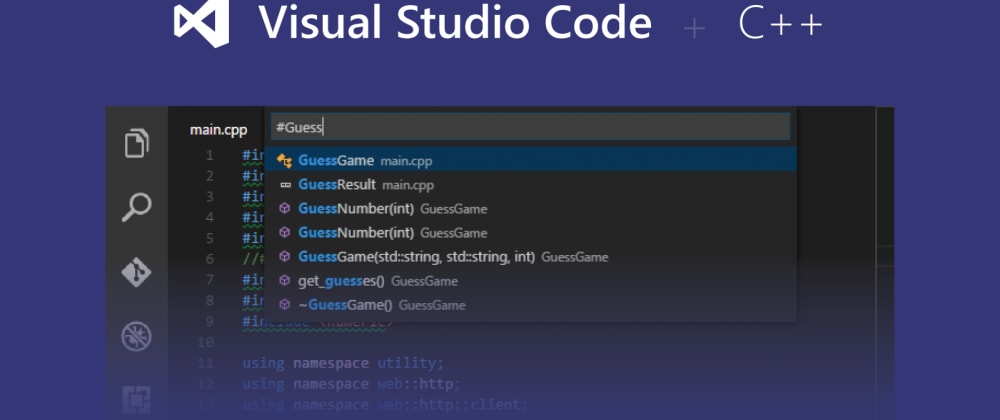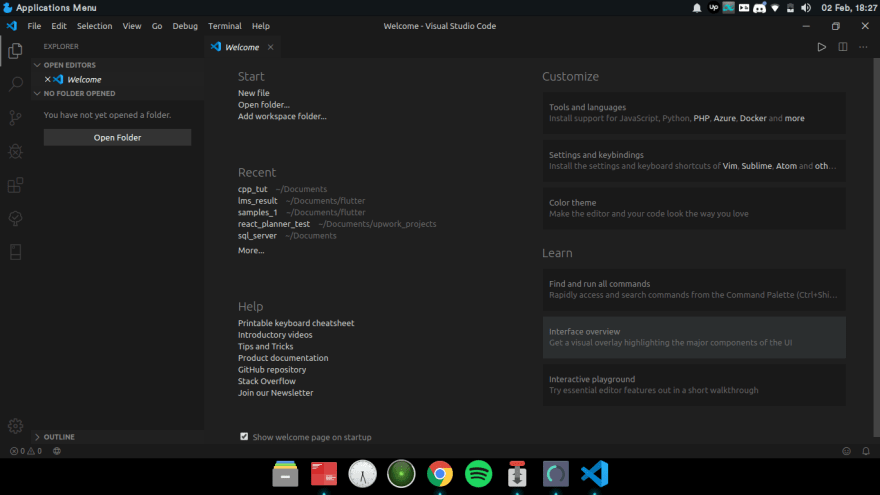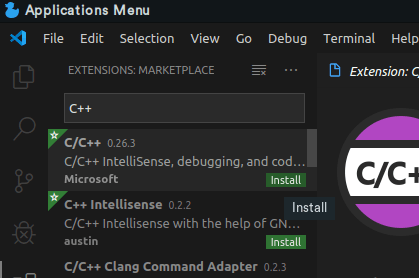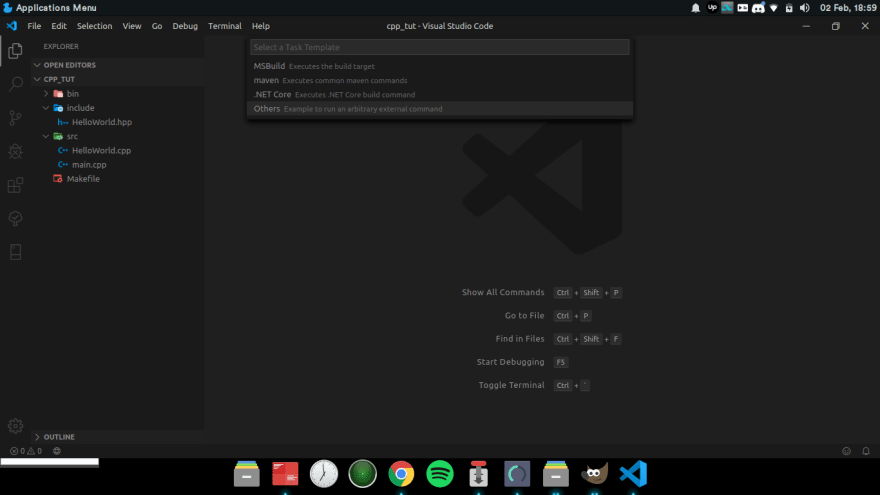Multi Process C Open and Read File

C++ is a statically-typed general-purpose linguistic communication middle-level programming language and superset of the C programming linguistic communication used everywhere but mainly in systems programming and embedded systems. It's as well used in making games with the Unreal engine.
In this article, I will show how to gear up upward C++ Compiler with Visual Studio Code. I'm writing this tutorial because I didn't discover tutorials with full information in a single place. So here are all the things I have collected from the Internet. I will cover the post-obit things.
Table Of Contents
- Installing
c++ compilerandbuild-tools - Installing VSCode and C++ Extension for VSCode
- Setting upwardly projection directory
- Setting up
Makefileand adding C++ files - Setting upwards VSCode
tasks.json- Configuring Trouble Matcher
- Setting upwardly
gdbas Debugger
Prerequisites
- A C++ Compiler (like yard++, clang, etc)
-
makebuild tool. - JSON know-how
- Visual Studio Code (you can get it here)
I will exist using Linux Operating Arrangement If you are on Windows try this tutorial. For macOS, for the most part, It volition be the aforementioned excluding the installing compiler role. You can cheque it here.
Let's go started.
Compiler and Build Tools Installation
I will be using GNU Compiler Collection so to install gcc, g++, gdb, and make. Y'all can run the following command in the final if you using Ubuntu.
$ sudo apt install build-essential gdb
on Fedora, you can run
$ sudo yum install make gcc gcc-c++ kernel-devel
on Arch-based Linux, you can run
$ sudo pacman -Syu base-devel
Installing VSCode and C++ Extension
Instaling the VSCode is fairly uncomplicated, check out this website and check for instructions to install VSCode on your computer.
One time VSCode is installed, open it. You should see the post-obit screen. Information technology may differ because I take changed my theme and have several other extensions.

Now, to install C++ extension goto extensions from the activity bar.

Search for C++ in the search bar and install C/C++ Extension By Microsoft.

Now let's movement to ready our project.
Setting Up Project Directory
Having a manageable directory structure is important. It tin assistance y'all rapidly empathize where you lot should look for a file. I opted for the following structure because information technology is uncomplicated.
├── bin ├── include └── src
The bin directory will comprise the executable after compilation, the include directory will contain all the header files, src will contain all the (as you accept guessed) source files.
Setting up Makefile and adding C++ files
Now that we have a directory structure let's write the Makefile. Open VSCode in your projection directory. Earlier that, Let's see what is a Makefile.
Makefile is read by the make utility which executes the tasks defined in Makefile when the files are modified. We will be using it to build our C++ lawmaking. Y'all can learn more near Makefile and make here.
For our purposes, following Makefile should piece of work well. so create a Makefile in the root of your project directory. It should spell exactly the same with a capital M.
CXX := thou++ CXX_FLAGS := -std =c++17 -ggdb BIN := bin SRC := src INCLUDE := include LIBRARIES := EXECUTABLE := main all : $(BIN)/$(EXECUTABLE) run : clean all clear ./$(BIN)/$(EXECUTABLE) $(BIN)/$(EXECUTABLE) : $(SRC)/*.cpp $(CXX) $(CXX_FLAGS) -I $(INCLUDE) $^ -o $@ $(LIBRARIES) make clean : - rm $(BIN)/*
If you want to add additional libraries, yous tin can add it afterwards the LIBRARIES variable. You tin can also change the name of the executable by irresolute the EXECUTABLE variable. You tin tinker with CXX_FLAGS to modify the compiler'due south behavior (i.e. C++ version) but be sure yous don't remove -ggdb flag or you won't exist able to debug the plan correctly.
Later on creating the file, our directory structure should look like this:
├── bin ├── include ├── lib ├── Makefile └── src
Now that we accept our base ready permit'south add some C++ files. I volition create a HelloWorld class that has a say() function that will print out (y'all guessed it) "Howdy, World". Let's create files in our project. I'thousand gonna utilise the command line, y'all can utilise VSCode or your file managing director.
$ touch include/HelloWorld.hpp src/HelloWorld.cpp src/main.cpp
Paste the post-obit code in the respective files.
Add following to HelloWorld.hpp.
#include <iostream> form HelloWorld { public: void say (); };
Add following to HelloWorld.cpp.
#include "HelloWorld.hpp" void HelloWorld :: say () { std :: cout << "Hello, World" ; }
Add following to main.cpp.
#include "HelloWorld.hpp" int master () { HelloWorld earth ; earth . say (); return 0 ; }
Testing our setup
Now, nosotros have all our project all set upwardly, we accept added some test files. allow's test everything out. Open a last in the project directory and run make.
~/Documents/cpp_tut ▶ make chiliad++ -std =c++17 -ggdb -Iinclude src/HelloWorld.cpp src/master.cpp -o bin/main
At present, in the output, we will say the exact control that nosotros would have run if we weren't using make. make has got our dorsum. We don't have to write the whole control each fourth dimension.
Full explanation of this can exist found here.
Setting up VSCode tasks.json
It is however a hurting to open up a last and type brand to build our lawmaking. We can do better than that. For this, we volition be using VSCode's task runner. With this, nosotros can map VSCode'southward build keyboard shortcut to task by making it of type build. The easiest way to fix tasks is to printing ctrl+shift+b. It runs the build task, but as nosotros don't accept any yet it will enquire us to gear up a build task. Later on pressing the push y'all should see the following.
Note: If you printing the shortcut while a C++ file is open, y'all volition encounter VSCode's default C++ build tasks. We don't want to utilise those. So, close the C++ and printing the shortcut once more

Select 'Configure Build task'

Select 'Create tasks.json from template'

Now, select 'Others'. Now you should see a file created, containing the following content.
{ // See https://become.microsoft.com/fwlink/?LinkId= 733558 // for the documentation about the tasks.json format "version" : "2.0.0" , "tasks" : [ { "label" : "echo" , "type" : "shell" , "command" : "echo Hi" } ] }
tasks.json contains all the tasks that VSCode tin can run for the states. In this case, I have created a task that runs a crush control echo Hello by default. Let's change it to make besides modify the label of the task to better explain the chore.
{ // Meet https://become.microsoft.com/fwlink/?LinkId= 733558 // for the documentation most the tasks.json format "version" : "2.0.0" , "tasks" : [ { "label" : "build" , "type" : "shell" , "command" : "make" , "group" : { "kind" : "build" , "isDefault" : true } } ] }
I besides added a property called grouping where I define what kind of task it is (i.e. build) and if information technology'southward default or non. Setting this is important for the build shortcut to run this task. Now try to build the code with ctrl+shift+b.
Setting up Problem Matcher
Problem matchers scan the task output text for known warning or mistake strings and report these inline in the editor and in the Problems panel. Information technology supports GCC. Then in the tasks.json file add the following in the nether the "grouping" property.
"problemMatcher" : "$gcc"
Now after running the build task, if whatsoever errors or warnings occur yous will see them in the problems console.
Setting up gdb as debugger
We have successfully built our lawmaking. At present nosotros are going to configure debugger. To add configuration press F5, A carte du jour will popular up asking you to choose which debugging solution you want to apply. Select 'C/C++' and it will generate launch.json in your project directory containing the following config.
{ // Use IntelliSense to acquire most possible attributes. // Hover to view descriptions of existing attributes. // For more data , visit: https://go.microsoft.com/fwlink/?linkid= 830387 "version" : "0.2.0" , "configurations" : [ { "name" : "(gdb) Launch" , "type" : "cppdbg" , "request" : "launch" , "plan" : "enter program name, for example ${workspaceFolder}/a.out" , "args" : [], "stopAtEntry" : false , "cwd" : "${workspaceFolder}" , "surround" : [], "externalConsole" : false , "MIMode" : "gdb" , "setupCommands" : [ { "clarification" : "Enable pretty-printing for gdb" , "text" : "-enable-pretty-printing" , "ignoreFailures" : true } ] } ] }
We are almost done, here change the "program" property to ${workspaceFolder}/bin/principal. Notation that if you changed the executable proper name change main with the name you wrote in the Makefile. At present, press F5 subsequently running the build, make certain the executable was generated, and resides in the path you just wrote in the "program" property.
In that location is one problem though, you always accept to run build earlier pressing F5 for debugging. Just, we can do improve add the post-obit in the launch.json after "setupCommands" property.
"preLaunchTask" : "build"
This should run the task we defined before starting the debugger. Press F5 and voilà, Code builds and debugger starts.
I'yard hoping this tutorial helped you. If you find any mistake or misinformation please allow me know.
Happy coding!
colethavervist1955.blogspot.com
Source: https://dev.to/talhabalaj/setup-visual-studio-code-for-multi-file-c-projects-1jpi
0 Response to "Multi Process C Open and Read File"
Post a Comment